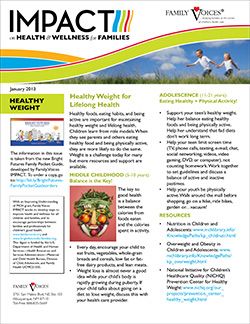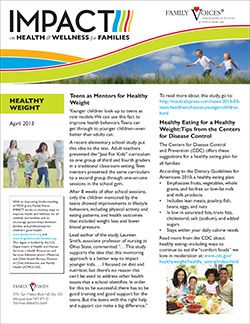
HEALTHY WEIGHT
SECTIONS: Background ~ Ages and Stages ~ What You Can Do

Promoting healthy weight is an important Bright Futures goal, due to the growing concern about overweight in children. There is also a relationship between healthy weight and overall health. Many factors affect a child’s weight. Key is what and how much a child eats. Your health provider can be a resource for information about nutrition – healthy foods and eating habits – and being physically active. These are important for maintaining healthy weight, and lifelong health. What parents eat and how much exercise they get also affects a child’s weight. Children learn from role models. When they see parents and others eating healthy food and being physically active, they are more likely to eat healthy food and exercise too.
Your health care provider can help you determine if your child is maintaining a healthy weight. The Body Mass Index (BMI) is the common screening tool for children, ages 2 – 19. BMI compares height, weight, and the child’s developmental age. Generally, a child is overweight if BMI is in the 85th percentile. This means the child weighs more than 85 out of 100 children the same age. A child is obese if weight is even greater. BMI can also help determine if a child is underweight. Being too thin is also unhealthy. Remember, it’s important to look at a child’s overall health and not just weight. Child and Family Children with weight issues are at risk for health problems such as diabetes and high blood pressure. Additionally, there may be social concerns. Children who are overweight are more likely to be teased or bullied, and may have low self-esteem. Different cultures have different ideas about health, weight, and physical activity. Cultural food choices may also affect a child’s weight.
Ages/Stages
- Infancy:
Families often worry if their babies are eating enough. Breastfeeding is one way to be sure your baby is getting enough food because your baby controls the feeding. If your baby is bottle-fed, your health provider can help you figure out how much and how often to feed your baby. Ask how to recognize when your baby is full. Babies need to be active, too. When your baby is awake, and you can watch, place your baby on her tummy. This is a good time for her to lift her head, move her arms and legs and explore. - Early Childhood:
These are the years when you can create family routines for healthy eating and physical activity. Limit "screen time"-TV, videos, and computers. Try to avoid screen time for children younger than 2, and no more than 1-2 hours a day for older children. Avoid snacking during screen time. Encourage physical activity throughout the day: take a walk, use the stairs, dance. Many young children are in childcare for all or part of their day. Be sure to ask about the kinds of food and activities available in these settings. -
Middle Childhood
Five to 10 year olds are developing their own ideas. And, while they pay a lot of attention to what their friends do and say, your opinion still counts! TV and other media also influence the foods and activities your children find desirable. If possible, try to watch TV with your child. Discuss food advertisements. Model the healthy eating and exercise habits you want your children to learn. Invite your children on walks, and encourage active indoor and outdoor play. -
Adolescence
Many teens worry about body image and the changes that happen during puberty. Some may try unhealthy diets that put them at risk for being too thin. Teens are also busy and may not always make healthy food choices. Many prefer to watch TV, text, and play computer games instead of being physically active. This can put them at risk for over weight. Provide healthy snacks and encourage daily physical activity. Try to take an active role at your child's school. Work with others to make sure there are healthy food choices in the cafeteria and vending machines. Work with your community to create opportunities for active play and sports for youth of all abilities. -
Children with Special Needs
Good nutrition and physical activity are important for children with special health needs too. Some medications affect appetite and cause weight loss or gain. It may be a challenge to make sure your child eats healthy food. It may also be hard for your child to be physically active. Talk with your child's health providers about ways your child can be active. Also, talk to other families to learn what others are doing to help their children be active and maintain a healthy weight.
What Can Families do to Promote Healthy Weight?
Create a family routine that makes healthy eating and physical activity part of daily life.
Other ideas to help promote healthy weight in your family:
-
Try to eat meals as a family and turn the TV off during meals.
-
Limit TV time and do not snack while watching.
-
Try to avoid using TV time or food as rewards.
-
Encourage your child to drink water and low-fat milk instead of juice and soda.
-
Celebrate "special family time" with games, books or music instead of food or TV.
-
Try new activities as a family: roller skate, fly a kite, take a walk in the park.
-
If your health care provider says your child is under or overweight, involve the whole family in lifestyle changes to promote healthy weight and physical activity.
ADDITIONAL RESOURCES:
Download Project IMPACT
1-page updates:
3 updates found





